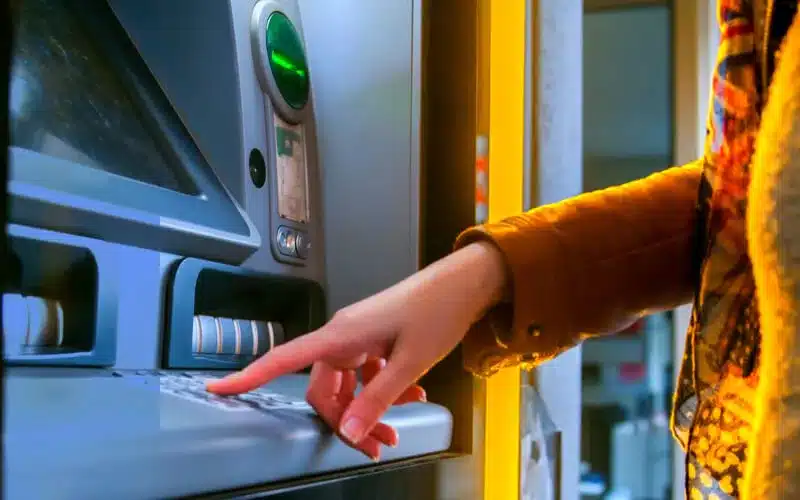An ATM (Automated Teller Machine) is an electronic machine used for financial transactions. As the term implies, it is an ‘automated’ banking platform that does not require any banking representative/teller or a human cashier.
Table of Contents
What is Automated Teller Machine – Definition
ATM full form is Automated Teller Machine which is a self-service banking outlet. You can withdraw money, check your balance, or even transfer funds. Different banks provide their ATM services by installing cash machines in different parts of the country. You can withdraw money from any of these machines irrespective of whether or not you are an account holder in the same bank.
Transactions are either free or bear a nominal charge depending upon the banks. Banks usually do not charge for the first 3-5 transactions in a month. Once you cross the limit of free transactions, you may have to pay a nominal charge. Also, some banks levy charges if you withdraw money from another bank’s ATM of which you are not an account holder.
RELATED: BBA Full Form – All about Bachelor of Business Administration
Types of Automated Teller Machines (ATM)
Automated Teller Machines (ATMs) are mainly of two types. One is a simple basic unit that allows you to withdraw cash, check your balance, change the PIN, get mini statements, and receive account updates. The more complex units provide facilities for cash or cheque deposits and line of credit & bill payments.
There are also onsite and offsite Automated Teller Machines: the onsite ATMs are within the bank premises, unlike the offsite ones which are present in different nooks and corners of the country to assure that people have basic banking facilities and instant cash withdrawals if they can’t go to a bank branch.
ATMs can also be categorized based on the labels assigned to them. Some of these labels are listed below-
- Green Label ATMs: Used for agricultural purposes
- Yellow Label ATMs: Used for e-commerce transactions
- Orange Label ATMs: Used for share transactions
- Pink Label ATMs: Specifically for females to help avoid the long queues and waiting time
- White Label ATMs: Introduced by the TATA group, white label ATMs are not owned by a particular bank but by entities other than the bank
- Brown Label Banks: Operated by a third party other than a bank
There are also a few biometric Automated Teller Machines that need fingerprints & eye scanners to be operated.
Uses of an Automated Teller Machine
Automated Teller Machines have revolutionized the banking sector by providing easy access to customers and loading off the burden from bank officials. Some of the uses of an ATM are-
- The most common uses of an Automated Teller Machine include withdrawing money and checking balance. Bank a/c holders can also transfer money or change the PIN (Personal Identification Number)
- Newer and advanced ATMs also provide options to open/withdraw a Fixed Deposit (FD), or to apply for a personal loan. You can also book railway tickets, pay insurance premiums, income tax & utility bills, recharge your mobile, and deposit cash. Some of these facilities may require you to register at the bank branch
- Customers can now do money transactions at their convenience. Banks have installed their ATMs today in public spaces, highways, malls, marketplaces, railway/airport stations, hospitals, etc.
- Automated Teller Machines provide 24×7 access anywhere
- It helps to avoid the hassle of standing in long queues at the bank even for simpler transactions like withdrawing money. It has also helped in reducing the workload of the bank officials
How to Use ATMs?
To avail of the facility of Automated Teller Machines, you need to have a bank account and an ATM card against the account for the same. Most of the time, banks issue a debit card that you can use not only at ATMs but also at online payment gateways or card swipe payments.
Every Automated Teller Machine has some common basic parts, even if they may differ in size and design. These are:
1. Input Devices
- Card Reader – Every Automated Teller Machine has a space to insert the debit or ATM card. The ATM card generally has a magnetic strip on the back, and in a few cases, a chip on the front, that contains the account details. Card Reader recognizes these details and passes them on to the user server
- Keypad – All ATMs have a keypad where you can insert numbers, clear them, or cancel any transaction. You can use it to enter the PIN and the amount you wish to withdraw. These keypads can either be physical buttons on the ATM or virtual keypads on the touchscreen
2. Output Devices
- Display Screen – There is a display screen in every ATM, usually LCD or CRT that displays the transaction information like steps to do the transaction or balance after withdrawal. Therefore, it acts as a guide to performing a transaction. It displays options for PIN change, quick cash withdrawal, balance checks, etc.
- Cash Dispenser – Cash is safely stocked into the Automated Teller Machine by bank officials. There is a cash dispenser from where you can collect cash after withdrawing a certain amount from the ATM
- Receipt Printer – After completing a transaction, the receipt printer in the ATM records the type of transaction, the amount withdrawn, and the remaining balance. In an ongoing transaction, ATMs generally display the question if the customers want the receipt or not. So, if requested, you get the receipt from the receipt printer
- Speaker – There is a speaker in most of the ATMs which gives audio instructions for accessing the machine & doing transactions. Therefore, it further enables the users to perform the transaction smoothly
To Conclude:
Thus, we see that ATMs have multiplied the accessibility and convenience of people. It helps people to have cash in times of urgent need. It is useful especially when you are not at the place of your bank branch where you hold an account or when banks are closed. You can withdraw cash even on bank holidays or after-work timings because you are not dependent on them.


